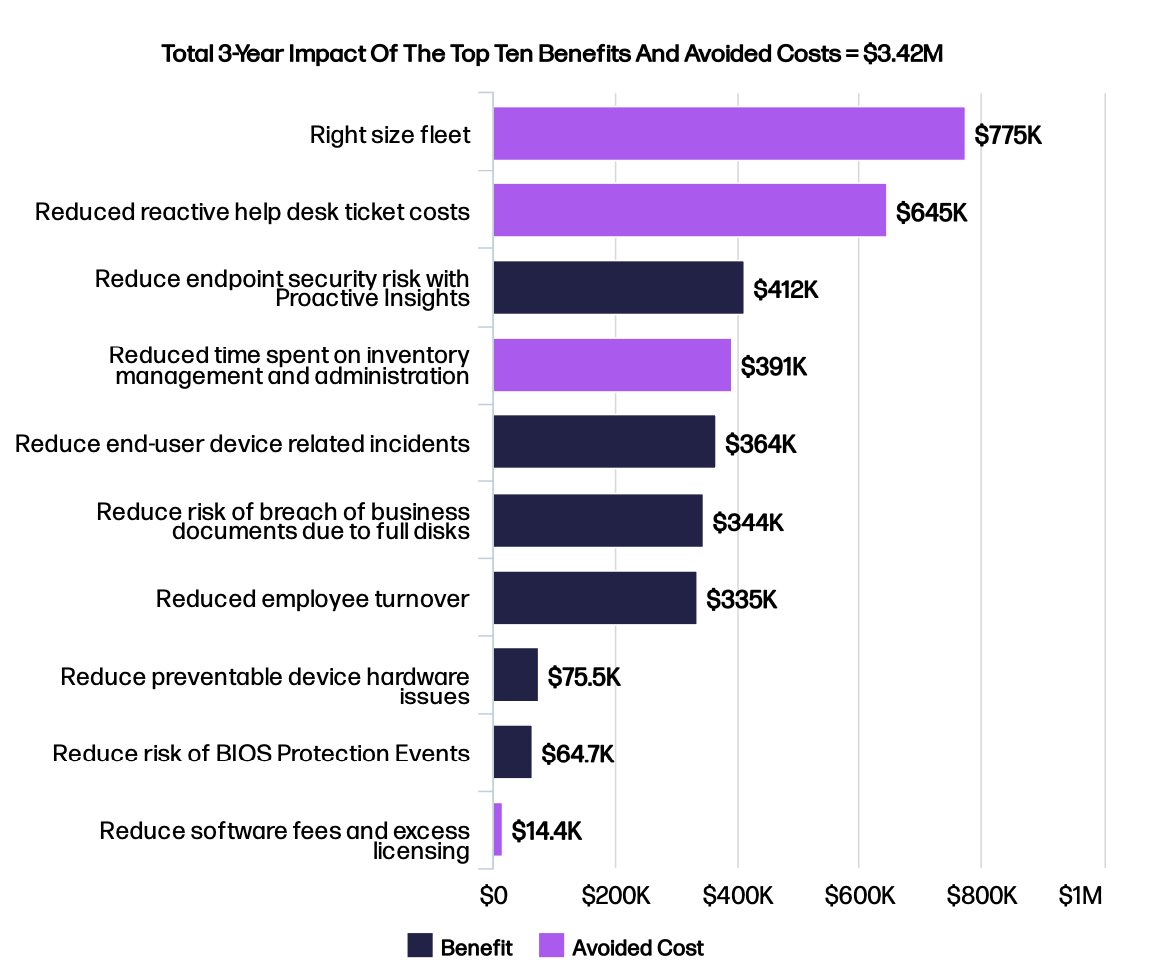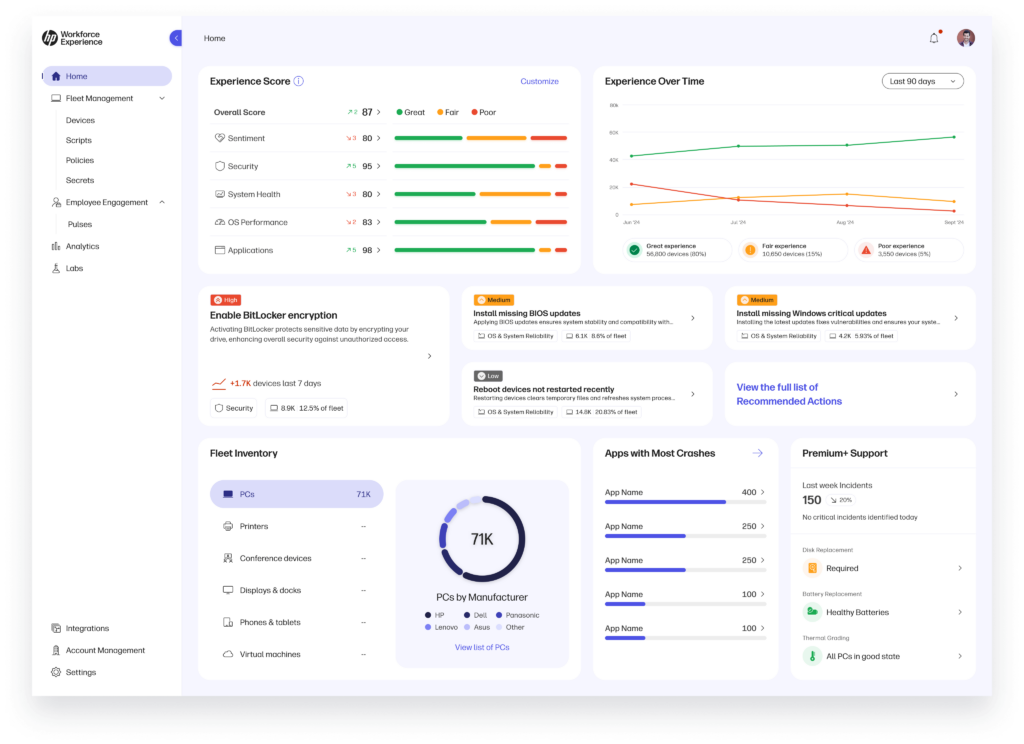The ROI of the HP Workforce Experience Platform

Table of contents
Executive Summary
Managing a hybrid workforce is highly complex and costly to organizations. Without the right tools, monitoring the employee experience and maintaining a secure environment is nearly impossible. Particular challenges include maintaining the health and performance of end-points (PCs, peripherals, enterprise print devices, conference room solutions, etc). Additionally, it’s more difficult than ever for technology executives to manage and monitor the strategic investments needed to achieve their business goals. HP’s Workforce Experience Platform (WXP) provides them with visibility over the performance and health of their entire IT investment, saving both time and money.
What is the HP Workforce Experience Platform?
HP Workforce Experience Platform (WXP) is a digital employee experience and fleet management solution that provides actionable data on a company’s IT investment through Employee Engagement, IT Fleet Management, Endpoint Security, Digital Workspaces, and Workflow and Software Management.
Framework and Methodology
HP conducted an evaluation of a customer with a 10k device fleet to better understand the potential financial benefits and ROI for organizations using our platform.
Before our solution, organizations:
- Used guesswork to make IT decisions that were costly and inflexible due to the lack of understanding of their IT assets and impact on employee productivity
- Frustrated end-users and increased help-desk tickets because they lacked visibility into emerging IT issues
- Had a high cost of fleet management and loss in productivity due to a lack of integration across different IT management tools across print, PC, and collaboration devices
- Lacked comprehensive security measures across endpoints leading to higher risk exposure, financial loss, and increased downtime
- Were unaware of employees who were silently suffering because companies lacked the necessary tools and insights to understand their digital experience and employee engagement
After investing in HP’s platform, technology executives have a more holistic, data-driven understanding of their digital workplace and employee digital friction points that impact productivity. IT teams can proactively anticipate and remediate device refreshes, security breaches, and endpoint issues. As a result, IT teams have more time to focus on more impactful tasks that improve employee engagement.
Key Findings
Tangible benefits
The following three-year, risk-adjusted quantified benefits are for this specific 10k device fleet:
- IT service savings worth $1.43M: This includes a reduction in end-user downtime valued at 14,609 hours, IT support estimated at 7,332 hours, and reactive help desk incidents by 7,592 hours.
- IT efficiency savings at $391K: IT teams save time in inventory management and administration with WXP, giving them time to focus on more impactful tasks.
- Device security risks valued at $821K: A 10% decrease in the likelihood of breach made security and IT operations more efficient and effective.
- Enhanced employee experience, resulting in $774K in value: With the reduction of end-user device-related incidents and preventable device hardware issues, employees at the organization avoid unnecessary downtime while enjoying and benefiting from high-performance devices.
Intangible benefits
When analyzing the business value of an investment, intangible benefits of our platform include:
- Improved communications across multiple functions: By enhancing collaboration across every touchpoint, the CIO, CHRO, CISO, and IT team can work together synergistically.
- Improved communications across IT teams: Through AI-driven support, IT teams at the organization have better workflows to anticipate and proactively resolve issues. This enables better coordination and collaboration.
- Improved IT recognition: An organization can better appreciate IT teams when they can fix user issues more efficiently and quickly.
- Improved employee engagement and satisfaction: An organization with less digital friction empowers its employees to work productively, increasing their engagement and satisfaction in the workplace.
| 3-Year Total | Year 1 | Year 2 | Year 3 | |
| Benefits | $1.6M | $476K | $532K | $588K |
| Avoided Costs | $1.82M | $608K | $608K | $608K |
| Investment | $326,250 | ($108,750) | ($108,750) | ($108,750) |
| Net Total | $3.09M | $975K | $1.03M | $1.3M |
Note: Benefit refers to softer savings that rely on detailed customer input to calculate, like the reduction of security risks. Avoided cost refers to hard savings with concrete data, like downtime costs.
Costs
Costs for the organization are $326,250 based on a three-year license to purchase the HP Workforce Experience Platform for a fleet of 10k devices. An organization experiences benefits and avoided costs of $3.42M over three years versus licensing costs of $326,250, which leads to an ROI of 847.1%.
Business Impact Summary
- Final value: $3.42M
- Net present value (NPV): $3.09M
- ROI: 847.1%
- Payback period: 3 months

Key Challenges of Hybrid Work
Some key drivers and challenges behind the investment into our platform are:
- Recognizing changing workforce needs: Amidst a rapid shift in work environments, businesses face a surge in devices, systems, and applications. As a result, actionable insights to meet the evolving needs of the workforce have become critical.
- Employee satisfaction and sentiment: Dynamic work environments have put significant stress on overall employee engagement. Providing seamless, delightful experiences across all touchpoints is key to improving employee engagement.
- Optimizing budgets: The evolving global macroeconomic landscape strains organizational budgets for software tools, processes, and people. Optimizing budgets effectively maximizes ROI and enhances costs with precision.
- Shortage of skilled IT labor: The demand for tech talent far exceeds the supply. As the competition for skilled IT talent intensifies, organizations must be able to alleviate overwhelmed IT members and hiring managers by reducing the number of IT incidents.
- Security and support: As organizations increasingly adopt hybrid work models, security and support challenges emerge. Proactively addressing cybersecurity challenges boosts employee productivity while decreasing costs.
Analysis of Benefits
| Three-year total | |
| Reduced IT service costs | $1.43M |
| Reduced security risk of devices | $821K |
| Enhanced Employee Experience | $774K |
| Amplified IT Efficiencies | $391K |
| License Costs | $326,250 |
| Total Savings | $3.09M |
Reduced IT service costs ($1.43M)
Data highlights a significant reduction in IT sourcing costs due to the following drivers:
-
Right size fleet ($775K savings):
- IT operations staff were better able to predict when devices needed replacing or upgrading to extend device life.
-
Reduced reactive help desk ticket costs ($645K savings):
- WXP offered device visibility that enabled the service desk to diagnose and fix device-related issues more quickly.
- AI-driven support identified and fixed L1 issues without any human involvement, saving time and costs for both the end user and the service desk.
- L1 service desk staff were able to complete more complex troubleshooting tasks, reducing the burden on L2 service desk staff.
- The platform’s integration within IT service management tools enables service staff to work in the same windows and applications, saving them time.
-
Reduced software fees and excess licensing ($14.4K savings):
- IT staff were also better able to detect the overuse or underuse of licenses, avoiding penalty costs and reducing spending, respectively.
Reduced security risk of devices ($821K)
This highlights the security-related benefits that the HP Workforce Experience Platform delivers. The main drivers include:
-
Reduced endpoint security risk ($412K savings):
- With visibility of all endpoints, the platform enabled security teams to remain confident about their security posture.
- The platform lets users see which endpoints lacked functioning protection measures so they can reduce those vulnerabilities.
- The platform reduced the amount of time necessary for monitoring PC security and implementing patches.
-
Full disks help to lower the risk of breach of documents ($344K savings):
- By providing insights on which disks are full, the platform allows security teams to prevent end users from placing sensitive information in unsecured locations.
-
Reduced risk of BIOS protection events ($64.7K savings)
- With the platform, an organization can see all security events. This made it easier for IT to quickly see which devices need to be isolated, build a fix, and implement it across all affected devices.
Enhanced employee experience ($774K)
Employee productivity was a key benefit of implementing our platform. As a result, employees are more engaged due to the following drivers:
-
End users face fewer device-related incidents ($364K savings):
- Through the right fleet size, endpoint security, and AI-driven support, employees experienced fewer issues with their PCs and increased productivity.
- Overall, this saved end users 4,033 hours.
-
Organizations deal with less employee turnover ($335K savings):
- Improving the performance of employees’ PCs improves their ability to complete tasks effectively, minimizing holdups and frustrations.
- The need to troubleshoot technical issues decreased, enabling employees to be more productive and engaged — key aspects of employee retention.
-
Preventable device hardware issues lowered ($75.5K savings):
- Organizations were able to manage hardware procurement and ensure the optimization of device configuration for different users with WXP.
- IT staff were also better able to match devices to personas, decreasing configuration requirements, reducing costs, or ensuring sufficient configuration requirements.
- Overall, this saved employees 837 hours per year.
Amplified IT efficiency ($391K)
Data highlights a significant amplification of IT efficiency due to:
-
Less time spent on managing and administering inventory ($391K savings):
- The amount of time it is necessary for IT staff to monitor inventory decreases, so they can focus on more high-level work and be more productive and engaged.
Intangible benefits
Other benefits realized that were intangible include:
- Improved employee engagement and satisfaction: An organization with less digital friction empowers its employees to work productively, increasing their engagement and satisfaction in the workplace.
- Improved communications across IT teams. The interviewee highlighted how improving visibility into device performance made it much easier for IT to agree on issues affecting endpoints. This makes it faster for IT to resolve issues.
- Improved IT recognition. IT teams can receive more appreciation and recognition by fixing problems faster, decreasing problems overall, and making more informed decisions.
- Improved employee productivity. An organization with less digital friction empowers its employees to work more productively, increasing their engagement and satisfaction in the workplace.
Analysis of Costs ($326K)
Licensing costs
HP Workforce Experience Platform offers a range of packages, which include a free, basic tier (freemium), and paid tiers that can be added to provide additional functionality and capabilities. Each package is designed to address specific IT, security, and employee engagement challenges, empowering organizations to uplevel the productivity of their employees.
Based on the interview with the customer, we assume the following:
- The licensing fees are dependent on the number of endpoints and the number of modules implemented.
- Results will vary depending on the number of endpoints and price.
Risk Assessment and Recommendations to Implementing WXP
Risks
- Upfront cost: There is an initial upfront cost to implement the platform, leading to an uncertain return on investment.
- Increased pricing: There is a possibility that pricing could be higher for different organizations, or that pricing could increase over time.
- Internal implementation and training: There are internal implementation and training costs associated with our platform. FTEs must dedicate time toward the implementation and training.
Recommendations
- Perform an ROI evaluation: Conduct a comprehensive cost-benefit analysis to determine the potential long-term benefits against the initial investment.
- Assess the contract continuously: Regularly review the contract to ensure it aligns with the evolving needs of the organization.
- Execute a strategic initiative: Develop a detailed implementation plan that aligns with the organization’s size. Provide comprehensive training programs, incentivizing users to dedicate time to learning.
Realizing Cost Savings with WXP
Managing the dynamic hybrid workforce poses challenges, especially in maintaining the health and performance of dispersed end-points. WXP emerges as a transformative platform, providing technology executives with visibility into all devices. This case study underscores the platform’s ability to drive substantial cost savings and enhance employee productivity with an 847.1% ROI in three years, making it an indispensable investment for organizations navigating the complexities of the evolving digital workplace.
HP Workforce Experience Platform is a comprehensive and modular digital employee experience solution that enables organizations to resolve IT issues before they arise, protect against cyber threats, and personalize IT for every employee’s needs.
Subscribe to the HP Workforce Experience Blog or schedule a consultation with our team to begin optimizing your IT capabilities today.
From the blog
The latest industry news, interviews, technologies, and resources.
Observe, Communicate, Execute: A Contingency Playbook for Microsoft Teams and Zoom Outages

Unlocking Outlier Detection Across the Digital Employee Experience
What Is the IT Asset Lifecycle? How to Maximize ROI from Your IT Investments




